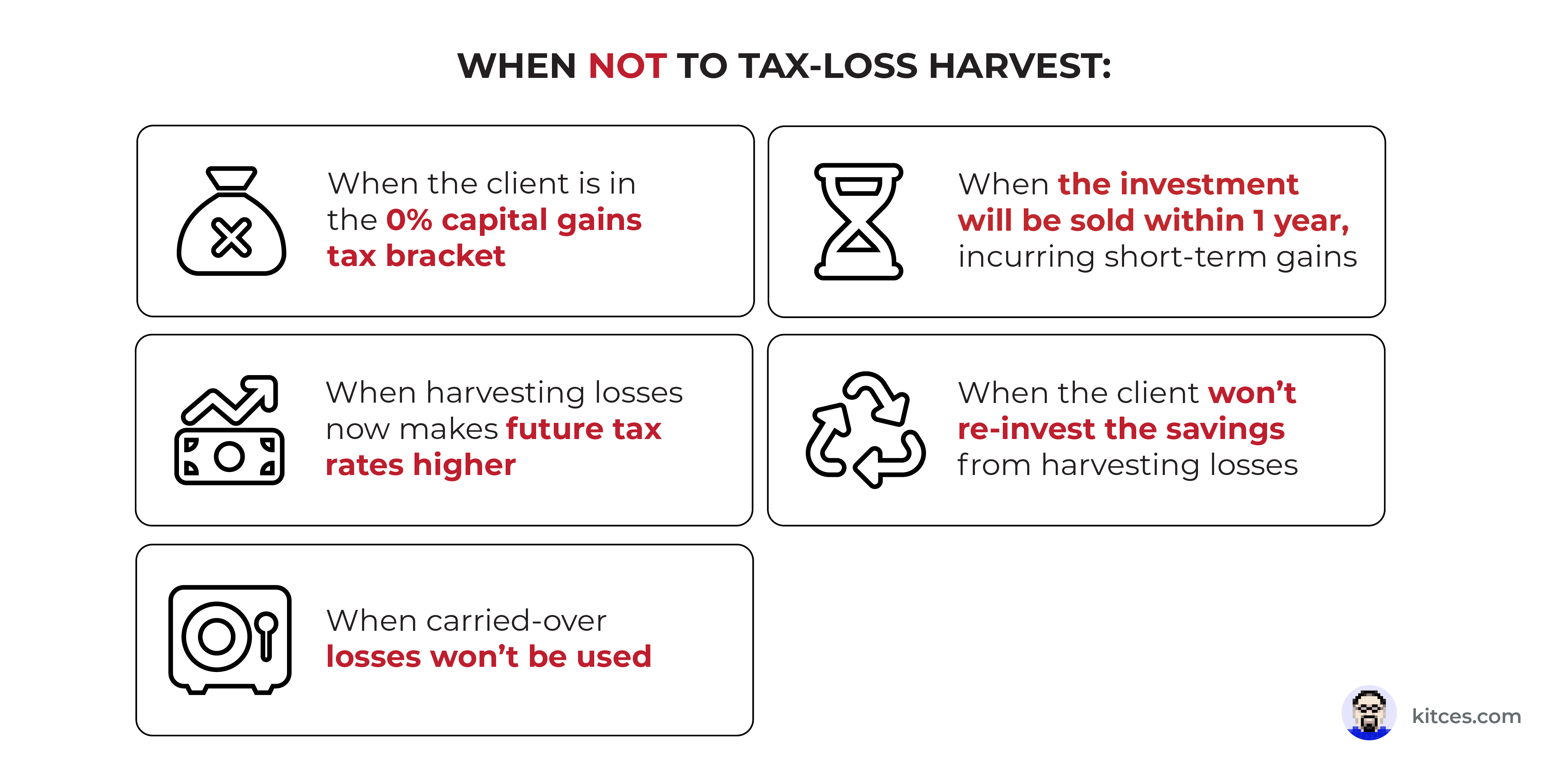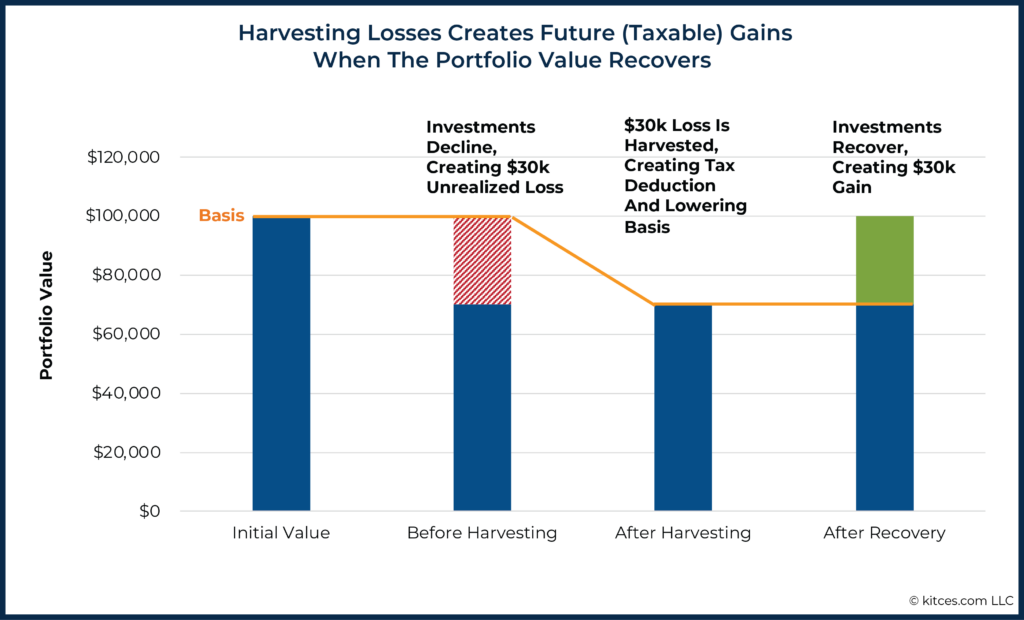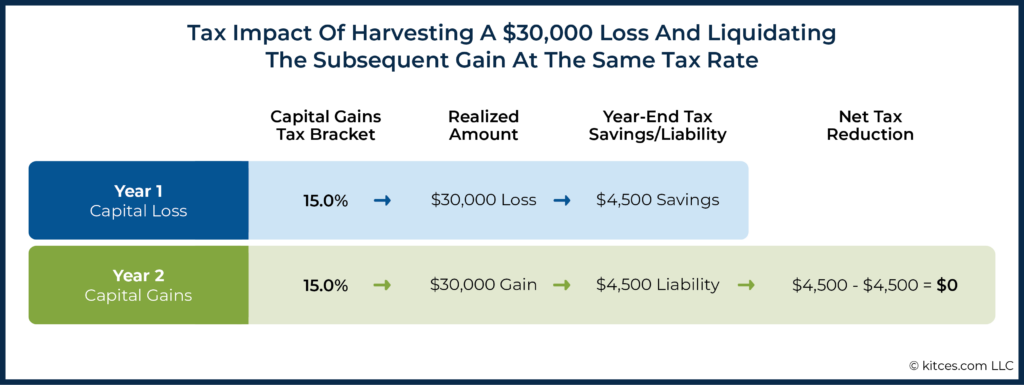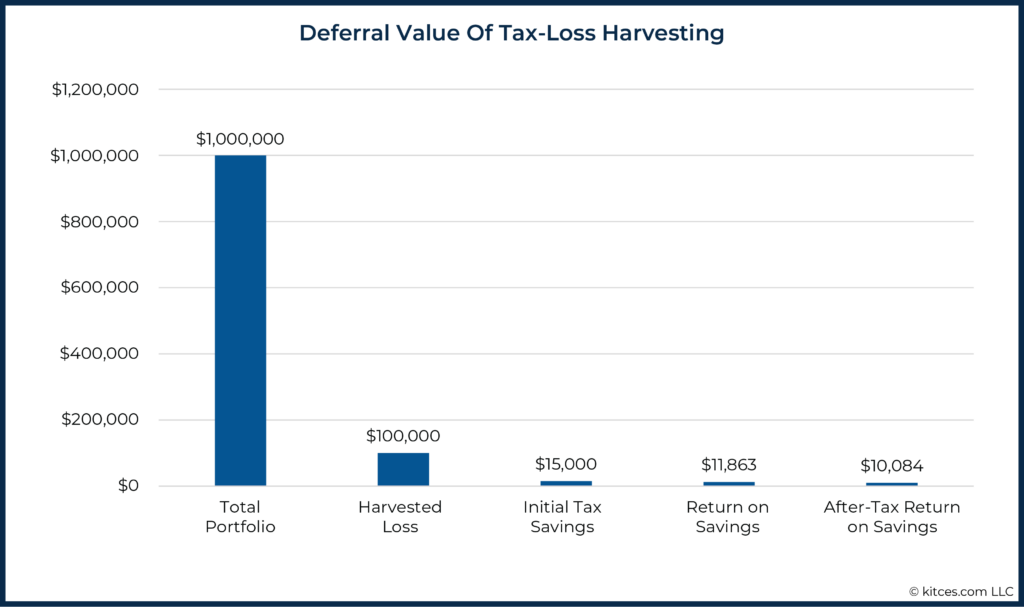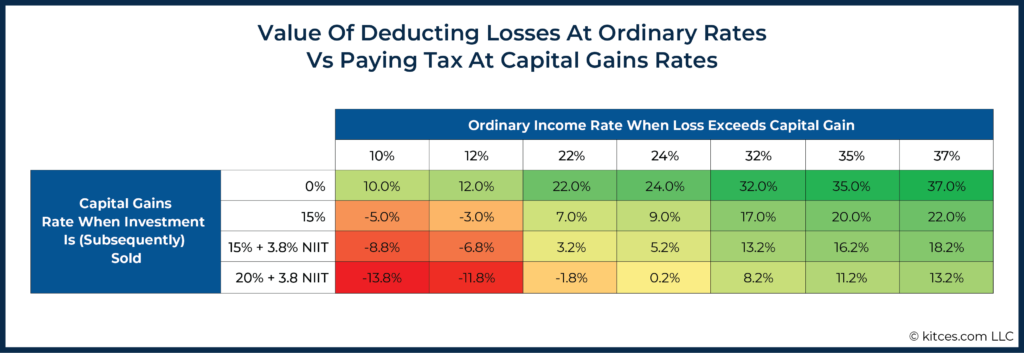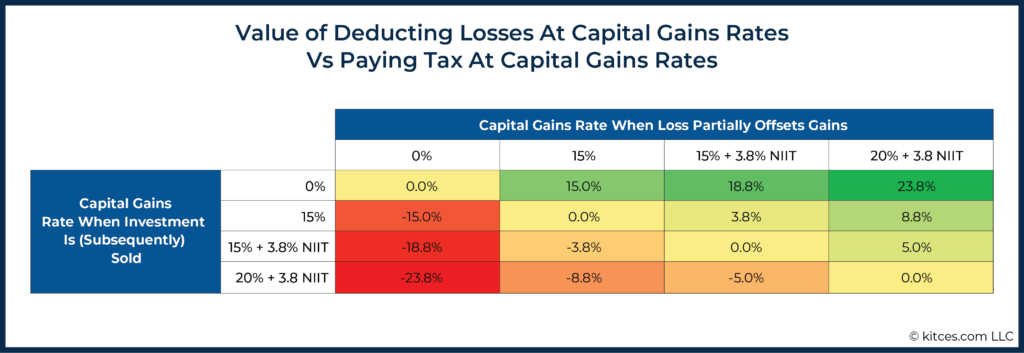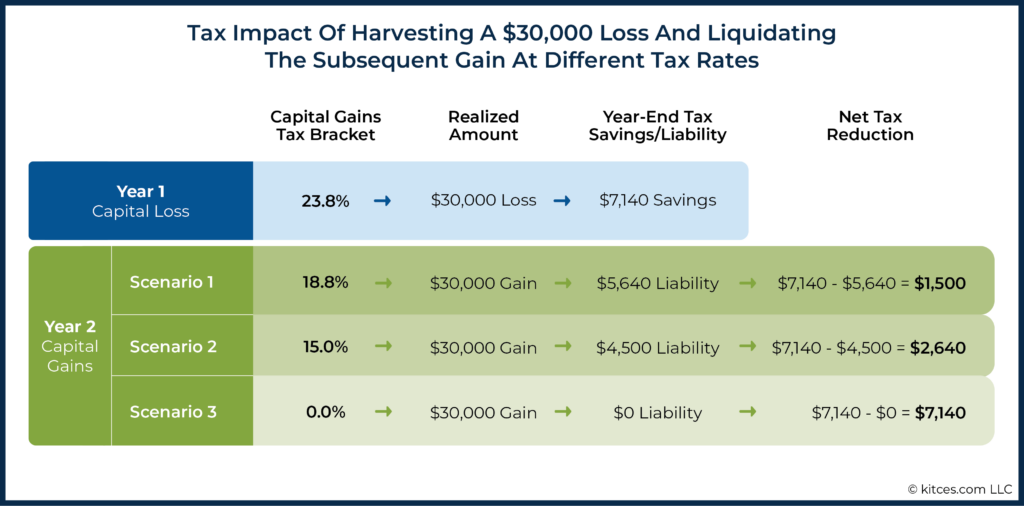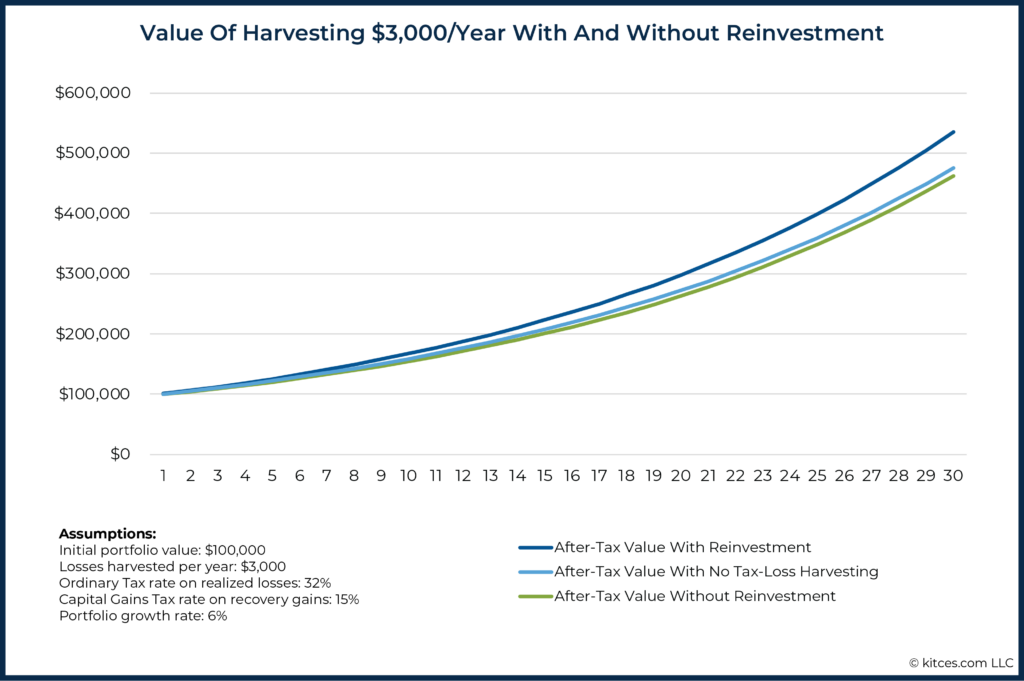Executive Summary
During market downturns, tax-loss harvesting is often considered a ‘silver lining’ to an otherwise undesirable situation. In theory, the strategy allows investors to convert their capital losses into a tax deduction while staying invested so they can benefit when markets recover – ostensibly a win-win for the investor and, consequently, a popular strategy for advisors who are often eager to find ways to provide extra value to their clients in volatile markets.
But contrary to this no-lose framing, there are situations where tax-loss harvesting results only in a net neutral outcome for the investor, and can even leave the investor worse off than if they had done nothing to begin with! This is because when losses are harvested, the investor’s cost basis in their portfolio is reduced by the amount of the loss. Which means that when the investment is ultimately sold (after it has recovered to or above its original value), there will be an additional capital gain equal to the loss that was harvested earlier – potentially negating some (or all!) of the initial benefit of harvesting the loss in the first place.
Whether tax-loss harvesting benefits the investor or not, then, depends highly on the investor’s tax rate when they deduct the initial loss, as well as the rate at which they realize the later gain that the initial loss created. If the investor is taxed on future gains at a lower rate than losses harvested today, the resulting ‘tax bracket arbitrage’ can create a net tax benefit. But the effect can also work in the opposite direction, and when the future gain is taxed at a higher rate than the loss today, the investor might be better off doing nothing (and not harvesting the loss), as in some cases, the additional capital gains created by harvesting losses could themselves push the taxpayer into a higher future tax bracket.
Additionally, when the goal of the investor is to build wealth, harvesting losses can be counterproductive if the investor doesn’t reinvest their initial tax savings because – along with losing out on the potential growth of that savings – spending it all upfront potentially requires the investor to pull additional funds out of their portfolio later on in order to pay for the extra capital gains created by harvesting the loss. And when the investor has large carryover losses from previous years that potentially won’t get used during their lifetime, tax-loss harvesting might potentially just create additional carryover losses, which are lost when the taxpayer dies and the cost basis is stepped down.
Ultimately, the value of tax-loss harvesting has a lot to do with an individual’s current and future circumstances, and financial advisors can take advantage of their knowledge of their clients’ financial pictures to identify when harvesting losses might be (or not be) a good idea. By taking the time to analyze the value of tax-loss harvesting – beyond the upfront tax deduction – advisors can help clients make well-thought-out choices about tax-loss harvesting that make them more likely to benefit from it in the long run.
When markets are down, one of the ways that many financial advisors like to show their value is through tax-loss harvesting. As the thinking goes, if the client’s ‘paper’ losses can be converted into a tax deduction, the advisor can provide a silver lining to the storm clouds of market volatility.
However, the benefits of tax-loss harvesting are often misunderstood. Because while the short-term tax savings are nice, the long-term effects of harvesting losses can sometimes – depending on the client’s circumstances – be worse for the client than doing nothing.
Advisors can help avoid these situations by deepening their understanding of where the value of tax-loss harvesting comes from, what situations should raise some red flags where harvesting losses might not be a great idea, and how to take all the relevant information into account before diving into harvesting any losses.
The Minimal Tax Deferral Value Of Harvesting Losses
Tax-loss harvesting is often framed as a simple matter of selling an investment for less than the owner originally paid for it, but, in practice, it can be a bit more complicated.
In general, the U.S. taxes investors on their net capital gains – that is, the total amount of capital gains minus the total capital losses during a given tax year. These ‘netting’ rules mean that a capital loss realized in one part of the year can be used to offset a capital gain realized at any time during the same year. If an investor knows they will need to liquidate some part of their portfolio during the year (and would likely incur a capital gain in doing so), realizing a loss at some point during the year can partially – or even entirely – offset that gain. The end result is a lower net capital gain at the end of the year and, therefore, a lower tax bill.
Example 1: Ed is a retiree who needs to withdraw $100,000 from his taxable portfolio at the end of the year to fund his living expenses for next year. Because of the growth in his taxable account over the years, the sale will incur a $50,000 capital gain.
However, with markets falling earlier at the beginning of the year, Ed’s advisor had sold some of the holdings in Ed’s portfolio to harvest $30,000 of capital losses, which is netted against the $50,000 of gains realized at the end of the year. This results in a net capital gain of $50,000 – $30,000 = $20,000 and a tax bill of $20,000 × 15% = $3,000 at a 15% Federal capital gains tax rate.
If Ed’s advisor had not harvested the $30,000 of losses earlier in the year, Ed would have owed $50,000 × 15% = $7,500 in capital gain taxes on the sale.
Thus, the losses harvested reduced Ed’s Federal tax bill at the end of the year by $7,500 – $3,000 = $4,500.
How Harvesting Losses Today Creates Future Tax Liabilities
The flip side to the benefit of harvesting losses is that the tax savings today can come at the cost of higher taxes later on. By selling some investments and using the proceeds to buy similar investments at lower prices, the investor lowers the overall tax basis of their portfolio. As shown below, this means that – after the portfolio has recovered its original value – the investor will have a capital gain that is the same amount as the loss that was harvested earlier on.
And if the investor pays the same capital gains tax rate when the investments are sold to harvest the loss as when the repurchased investments are later liquidated to withdraw cash, the upfront tax savings when the loss is harvested will be equal to the ‘recovery gain’ that will be realized when the investments are eventually sold. In this scenario, then, tax-loss harvesting does not permanently reduce taxes, but effectively just defers them until the portfolio is subsequently liquidated.
Example 2: Ed, from Example 1 above, plans to liquidate his portfolio entirely next year. Because of the $30,000 of losses he harvested this year, Ed’s tax basis in his portfolio is $30,000 lower than it would have been without the loss harvesting. If the portfolio recovers its initial value before then, all $30,000 will be realized as a capital gain when he liquidates the portfolio.
Again assuming a 15% Federal capital gains tax rate, Ed will pay an extra $30,000 × 15% = $4,500 in taxes as a result of the sale next year – the exact same amount that he ‘saved’ last year when he harvested the losses. As seen below, the investment gains and losses – and the respective tax savings and liability that result –offset each other exactly when the portfolio is liquidated.
Even though tax-loss harvesting often only defers taxes rather than actually reducing them, there can still be benefits in the deferral alone. If Ed, in the example above, were to reinvest his $4,500 in tax savings from the first year (or simply withdrew $4,500 less from his portfolio), and if the investment grew over the following year, he would have more when he liquidates the portfolio than he would have without harvesting the loss. And the longer he is able to defer paying taxes on that gain, the more additional wealth will compound over time as a result.
Calculating The Tax-Deferral “Alpha” Of Tax-Loss Harvesting
But to be realistic, the pure tax deferral benefits of tax-loss harvesting may be marginal when considering the net return of harvesting losses in the context of the size of the overall portfolio. In a broad-based market decline like we have seen so far in 2022, many portfolios will have multiple securities at a loss position that could potentially be harvested for potential losses, meaning that the implications of tax-loss harvesting may stretch beyond any one security.
In this context, we can think of the value of tax-loss harvesting as the difference between the size of the overall portfolio with harvesting the losses (and reinvesting the tax savings from doing so), and that of the portfolio without harvesting. And depending on the initial size of the portfolio, and how large the initial tax savings is as a percentage of the portfolio’s size when the loss is harvested, the net tax deferral benefits may only represent a small slice of alpha beyond the return that would have been attained without harvesting losses.
Example 3: Anastasia is an investor with a $1 million portfolio. During a down year in the markets, she harvested $100,000 in losses (all of which were offset against realized capital gains). She is in the 15% tax bracket for capital gains income.
Anastasia’s initial tax savings on the loss was 15% × $100,000 = $15,000. She reinvests that savings, and over the next 10 years, her portfolio returns an average of 6% per year, making up for her initial loss and then some.
If Anastasia liquidates her portfolio after those 10 years, the capital gains tax from recovering her initial loss would be $100,000 × 15% = $15,000 – the same amount as her initial tax savings from harvesting the loss. But because she invested the initial savings in her portfolio, the original $15,000 has grown to $15,000 × 1.0610 = $26,863. After paying the $15,000 in capital gains tax, the remaining $26,863 – $15,000 = $11,863 represents the total return from Anastasia’s tax-loss harvesting.
Of course, the $11,863 itself also represents a capital gain, which itself would be taxed. Assuming Anastasia is still in the 15% tax bracket, then, the net total after taxes are paid would be $11,863 × (1 – 0.15) = $10,084.
So in this case, the ‘alpha’ of harvesting a $100,000 loss – equal to 10% of Anastasia’s entire portfolio – is only $10,084 ÷ $1,000,000 = 1.0084% cumulatively over 10 years – or on an annualized basis, only 0.1% per year.
Of course, all things being equal, some alpha from tax deferral – amounting to 0.1% per year in the above example – is still better than nothing. But with tax-loss harvesting, all things are not equal: the wash sale rule (IRC 1091) prohibits investors from recognizing a capital loss on a security when it is replaced by a “substantially identical” security within 30 days before or after the sale, which means that whichever investment replaces the one that was sold to capture the loss will be prone to at least some ‘tracking error’ during the wash sale period due to the slightly different nature of the new replacement investment. And when the alpha from the tax deferral alone is small to begin with, even minor underperformance from the replacement security compared to the original can quickly destroy whatever value the tax deferral created.
The tax deferral value of tax-loss harvesting, then, is highly dependent on the amount of initial tax savings the deferral can achieve as compared to the overall portfolio value and how long (and at what rate) those savings can grow over time. Though tax-loss harvesting can create some economic ‘tailwinds’ if the conditions are right, other factors – such as an unlucky choice of replacement security – can easily counteract those benefits. In the end, then, tax deferral alone may not be a great reason to employ tax-loss harvesting – unless there are other factors that can increase the value of the strategy.
Tax Bracket Differences Can Increase The Value Of Tax-Loss Harvesting
Though the tax-deferral value of tax-loss harvesting may be minimal, there are other situations where it can produce a much better outcome. Specifically, when the capital loss generates a deduction at a higher tax rate than the recovery gain when it is sold, the difference between the rates represents tax savings for the investor – a concept known as tax bracket arbitrage. There are several scenarios where this could be possible:
- When an investor realizes a capital loss with no gains to offset it (or if the total losses exceed the total gains for the year), up to $3,000 of the loss can be deducted from the taxpayer’s ordinary income, which is usually at a higher tax rate than the capital gains rate
- When an investor realizes a capital loss in a higher capital gains tax bracket, and the recovery gain is later sold when they are in a lower capital gains bracket
- When an investor realizes a capital loss and they never sell the security but leave it to their heirs for a step-up in basis, or donate it to a charitable organization where the capital gain is never recognized
Harvesting Losses Against Ordinary Vs Capital Gains Income
Tax-loss harvesting is often used to offset capital gains that are already being realized in the portfolio. But when there are no capital gains to offset – or the total losses harvested exceed the total gains for the year – another tax rule kicks in: taxpayers are allowed to deduct net capital losses of up to $3,000 (for both single and joint filers) against their ordinary income per year. If the taxpayer’s net loss is greater than $3,000, the remainder gets carried over to the next year (when it can again be used to offset gains or take another deduction up to $3,000 against ordinary income if there are no capital gains to offset).
Since ordinary income tax rates tend to be higher than long-term capital gains rates, this method of tax-loss harvesting can often work out positively for taxpayers.
Example 4: Faye is an investor who harvests $5,000 in losses in her portfolio this year. Her income puts her in the 24% ordinary income tax bracket and the 15% capital gains bracket.
If Faye has no capital gains for the year, she can deduct $3,000 of the losses against her ordinary income, which will lower her tax bill by 24% (ordinary income tax rate) × $3,000 = $720. The remaining $2,000 of unused losses gets carried over to next year. If she also has no other gains or losses next year, she can deduct the $2,000 of carryover losses against her ordinary income for that year, too, lowering her tax bill again by $2,000 × 24% = $480.
In three years, the replacement investment Faye bought after harvesting gained $5,000 in value, making up for Faye’s original loss. If she then sells the investment, she will pay 15% (capital gains tax rate) × $5,000 = $750 in capital gains taxes.
By harvesting the losses initially, Faye reduced her ordinary income taxes in the first two years by $720 + $480 = $1,200. In the third year, she paid $750 in capital gains taxes after her portfolio recovered its original value. So Faye’s total savings over three years from tax bracket arbitrage was $1,200 (income tax savings in years 1 and 2) – $750 (capital gains tax due in year 3) = $450.
With tax bracket arbitrage, the value of the tax savings is determined by the difference between the tax rate when the deduction is captured and the rate when the investment is subsequently sold. The many potential outcomes of deducting losses at ordinary income tax rates and capturing recovery gains at capital gains rates are as follows:
Value Of Deducting Losses At Ordinary Rates Vs Paying Tax At Capital Gains Rates
The first thing that stands out is that, despite the perception that ordinary income tax rates are always higher than capital gains rates, there are still circumstances where this type of loss harvesting could create negative value. For taxpayers in the 10% and 12% ordinary-income brackets, it can only work out positively if the investment is ultimately sold at the 0% capital gains rate.
And considering that the upper-income thresholds for the 12% ordinary income bracket ($40,525 single; $81,050 married filing jointly) and the 0% capital gains bracket ($40,400 single; $80,800 married filing jointly) are so close together, someone just below the capital gain income threshold might find that a small boost of income may suddenly have them owing more taxes on their recovery gains than they saved when the loss was harvested!
While the potential rate differences improve for taxpayers in the higher ordinary income tax brackets, the $3,000 annual limit of losses that can be deducted against ordinary income puts a hard cap on the tax savings that can be realized this way. Because no more than $3,000 can be deducted in any year (an amount that does not increase annually with inflation), the maximum annual tax savings from this strategy for someone in the highest ordinary income bracket (37%) and the lowest capital gains tax bracket (0%) tops out at $3,000 × 37% = $1,110. For those in lower ordinary income brackets or higher capital gains tax brackets, the value goes down from there.
Maximizing Differences Between Capital Gains Brackets
When there are capital gains to offset with harvested losses, the initial savings for those losses show up not as a literal deduction, but rather as a reduction in the net capital gains income recognized by the taxpayer during the year.
Thinking back to the main principle of tax bracket arbitrage, the value of the strategy is the difference between the tax rate where the deduction is captured and the rate when the investment is ultimately sold. In this case, since the initial deduction is against capital gains, we can use capital gains rates to calculate the value of both the deduction and the recovery gain, as shown below:
What immediately stands out here is that, for taxpayers in the 0% capital gains bracket, there is never value in tax-loss harvesting when it is being used to offset gains. In those cases, it is better to harvest gains where they exist (or as much as is possible while remaining in the 0% capital gains bracket) and leave losses untouched.
For taxpayers in higher capital gains brackets, on the other hand, the value of harvesting in a higher bracket and liquidating in a lower bracket can produce significant tax savings that are highest when the investment can ultimately be sold in the 0% capital gains bracket.
One common scenario where this might happen would be an individual who retires several years before claiming Social Security benefits or making withdrawals from tax-deferred retirement accounts, and therefore has several low-income years where the 0% capital-gains bracket can be filled by capital gains income. In this case, there are two ‘harvests’: the loss (at higher capital gains rates) during working years, and the gains (at 0% capital gains rates) after retirement but before Social Security and tax-deferred retirement account withdrawals begin.
Example 5: Victoria is a 60-year-old investor who plans to retire at age 65. This year, she harvested a $60,000 loss in her taxable portfolio. Her current income puts her in the 18.8% capital gains tax bracket (15% plus the 3.8% Medicare surtax), so her tax savings from the loss amounts to 18.8% × $60,000 = $11,280.
After Victoria retires, she plans to fund her living expenses using withdrawals from her taxable portfolio while delaying Social Security until age 70. Her advisor estimates that Victoria will be able to recognize about $40,000 in capital gains per year while remaining in the 0% capital gains bracket during the five-year period between retiring and reaching age 70.
Assuming her portfolio is able to recover enough to make up for the $60,000 initial loss before she retires, Victoria can harvest all of her recovery gains in the 0% tax bracket by recognizing $40,000 in the first year of retirement and the remaining $20,000 in the second year.
Because she reduced her taxes by $11,280 from deducting the initial loss, then recognized the capital gains after recovering from the loss in the 0% capital gains bracket, the value of harvesting the loss is the entire $11,280.
The caveat with this strategy is that there is typically a finite amount of capital gains that can be captured at 0% since the window to do so may only be a few years (or less). If harvesting losses results in high enough capital gains later on that they surpass the investor’s ability to capture gains at 0%, it reduces the overall value of harvesting the loss.
Harvesting Losses Before Donating/Bequeathing Investments
Finally, there are times when an individual may own an investment that they never plan to sell. Perhaps they will contribute it to a charitable organization or donor-advised fund for a tax deduction (where the capital gain is never triggered and recognized). Or maybe they will hold on to it until they die, leaving it to their heirs (who will receive it with a basis that is stepped up to the value on the original owner’s date of death). Either way, the capital gains from the investment will be wiped away without the investor owing any tax on the appreciation.
In this case, as seen below, it generally makes sense to harvest losses when the asset will eventually be donated or left to the investor’s heirs (though there are exceptions, as will be covered further below).
Unlike the earlier scenario of harvesting gains at 0%, there is no limitation to the amount of gains that can be erased by donating or dying with an appreciated asset, so it is often best to maximize the amount of losses harvested (and thereby the amount of potential appreciation that will be wiped away).
When Is Tax-Loss Harvesting NOT A Good Idea?
Given the potential benefits of tax-loss harvesting, investors often look to realize harvested losses as much as possible. And when markets are down broadly as they have been for much of the year so far, advisors may be eager to get a ‘win’ and show their value by harvesting losses to create some initial tax savings for their clients.
But as we’ve already seen, there are situations where tax-loss harvesting can actually create a negative outcome for investors. By looking out for some potential red flags, though, advisors can help avoid situations where harvesting losses today becomes a regrettable decision in the future.
When The Client Is In The 0% Capital Gains Tax Bracket
One situation where it almost never makes sense to harvest capital losses is when a taxpayer is in the 0% capital gains bracket. This is especially the case when there are capital gains that the losses offset, since those gains would have been taxed at 0% anyway. And in the future, the lower basis created by harvesting the loss creates the potential for more capital gains, which even a modest increase in income could cause to be taxed at 15% (or higher).
The potential exception to this might be when there are no capital gains to offset, and the loss is deducted against ordinary income. Since the 0% capital gains bracket aligns with the 10% and 12% ordinary income brackets, there might be some initial tax savings in this case. But the taxpayer only comes out ahead if the tax savings from the initial loss is greater than the tax they owe when the investment is eventually liquidated. A modest boost in income might bump the taxpayer from the 0% to the 15% capital tax bracket, in which case the taxes from liquidating the recovered investment would be higher (at 15%) than the initial tax savings from harvesting the loss (at the 10% or 12% ordinary income brackets).
Taxpayers in the lowest income tax brackets – 10% and 12% for ordinary income, and 0% for capital gains – need to be mindful of their expected future income and tax situation to gauge whether harvesting capital losses is really worthwhile for them. And while advisors may not know exactly where a client’s future tax bracket will fall, they can take some clues from which tax bracket they currently occupy, where they lie within that bracket, and the trajectory of their future income and wealth creation.
For example, a married couple with $150,000 of taxable income is firmly within the 15% capital gains bracket (which, for 2022, ranges from $83,350 up to $250,000, where the 3.8% Medicare surtax on net investment income kicks in). The couple would need a significant swing in income in one direction or another to reach another bracket – not that it couldn’t happen, but a reasonable expectation would be for them to stay in their current tax bracket for the foreseeable future, barring any major life changes that would impact their income.
On the other side of the coin, a taxpayer near the threshold between one bracket and the next might warrant some extra planning if they were to cross over.
Example 6: Spike and Julia are a married couple who, after retirement contributions and the standard deduction, will have $80,000 in taxable income this year, which puts them in the 12% marginal tax bracket for ordinary income and the 0% bracket for capital gains.
Julia is in the running for a promotion that, if she receives it, would increase their taxable income to $100,000. This would bump them into the 22% ordinary income bracket and the 15% capital gains bracket.
If the couple is sitting on embedded losses in their taxable account, realizing those losses now, when their capital gains tax is at 0%, could result in four different potential outcomes, depending on whether or not Julia receives the promotion and whether the losses are used to offset other gains or deducted (up to $3,000) against ordinary income:
Without knowing whether Julia will receive the promotion in the future, it would be risky to capture the loss now, especially if there are capital gains that the loss would offset.If Julia does not receive the promotion, the value of the deduction would be $0 since it would offset gains that would have been taxed at 0% anyway. Furthermore, if they eventually do raise their income enough to get into the 15% tax bracket, any extra gains caused by the lower tax basis created from capturing the loss would be taxed at that rate – effectively creating a tax liability out of nothing.
Therefore, it would be best to wait to harvest any losses when they know whether Julia gets the promotion. If she does get promoted, harvesting losses could have some value – but given the outcome if she doesn’t, it would be best to wait and see.
Notably, while we often think of the ‘initial’ tax savings of tax-loss harvesting as occurring in the year the loss is harvested, that isn’t always the case. When losses are carried over into future years and used to offset future capital gains, the value of the initial tax savings is based on the investor’s tax rate when the gains are offset, not in the year the loss is harvested.
So even if the investor weren’t in the 0% capital gains bracket today, it would still be best to tax-loss harvest with care, especially when any carryover losses might offset future gains that would otherwise be taxed at 0%. Because gains must be offset with any carryover losses that are available – that is, taxpayers can’t choose to continue carrying over the losses rather than offsetting gains. Which means that incurring carryover losses runs the risk of being unable to avoid using them in the 0% tax bracket later on, when it would be preferable to realize gains instead.
When The Investment Will Be Sold Within One Year, Incurring Short-Term Capital Gains
So far, when describing the value of tax-loss harvesting, we have assumed that the recovery gains are taxed at Long-Term Capital Gains (LTCG) rates. However, in order to be taxed at those rates, an investment must be held for more than one year; otherwise, it would be taxed at Short-Term Capital Gains (STCG) rates, which are generally equal to the taxpayer’s ordinary income rates and therefore higher than LTCG rates.
As described above, tax-loss harvesting resets an investment’s basis at its value when the loss is harvested. However, harvesting the loss also resets the holding period ‘clock’ that determines whether the investment will be taxed at LTCG or STCG rates when it is sold. So if the investment – either the replacement investment bought after harvesting the loss, or the original investment if it was bought back after the wash-sale period – appreciates in value after the loss is harvested, the higher value will not only represent a capital gain, but it will be a short-term capital gain until one year plus one day after the investment was purchased. And if the original loss was harvested against LTCG rates, realizing the recovery gain at STCG rates is likely to result in a higher tax liability than the initial tax savings of harvesting the loss.
It is essential, then, for advisors to understand their clients’ plans for liquidating or withdrawing from their investments before going through with tax-loss harvesting. If they plan to liquidate within one year, harvesting the loss could turn a long-term capital loss into a short-term capital gain, which would result in the client paying more taxes on the sale than they saved from the loss.
When Harvesting Losses Makes Future Tax Rates Higher
One way to describe tax-loss harvesting is that by harvesting losses, you are exchanging lower taxable income today (by deducting the loss) for higher taxable income in the future (by lowering the basis of your investment, which will increase the potential capital gain when the investment is eventually liquidated).
Some taxpayers will have the ability to absorb this extra income without getting bumped into a higher tax bracket. But for others, the addition of the extra capital gains income in the future caused by harvesting losses today could put them over the threshold, which could make the difference between whether the strategy creates a positive or negative value overall.
Because of this Catch-22-like dilemma – where conditions that are at first glance favorable for tax-loss harvesting are made unfavorable because of the effects of harvesting those losses – it is essential, when analyzing a client’s current and future tax rates for tax-loss harvesting, to factor in the effects of the lower cost basis (and consequently higher potential capital gains income) on the client’s tax situation. If you exchange the deduction today at 15% capital gains rates for future income that will be taxed at 18.8% or 23.8%, that is not a great deal.
When Tax Savings Aren’t Reinvested
Advisors commonly state that harvesting losses on a regular basis can enhance the after-tax returns of an investor’s portfolio, and research has backed up this claim because of the (modest but still valuable) benefits of generating growth on the tax savings from the gains that were deferred. One important caveat, however, is that in order for the ‘alpha’ of tax-loss harvesting to show up, the tax savings from deducting losses need to be reinvested.
It’s worth re-emphasizing that, while tax-loss harvesting creates immediate tax savings in the form of a tax deduction, it also creates a future tax liability by lowering the cost basis of the investor’s portfolio. Part of the initial tax savings will be needed to pay for that future liability – but if the immediate savings is spent instead, then paying for the liability requires tapping into the rest of the portfolio.
Example 7: Jet is an investor in the 32% ordinary income and 15% capital gains tax brackets and harvests a $3,000 loss that will be deducted from ordinary income. The loss will have an immediate tax savings of $3,000 × 32% = $960.
Assuming he will liquidate the investment sometime after it has recovered its original value, he will pay capital gains taxes of $3,000 × 15% = $450.
By harvesting the loss, Jet has created immediate tax savings of $960, and a future tax liability of $450. If he reinvests the initial $960 saved, he will be able to keep the difference between the savings and the tax liability ($960 – $450 = $510) if we assume the savings invested will also be used to pay for the future tax liability, plus any growth on the entire $960 that accrues between now and when he liquidates the investment (though that growth itself might also be taxed).
However, if he spends the entire $960 of initial savings rather than reinvesting it – for instance, because the harvested loss reduces his tax liability and results in a (bigger) tax refund, which he deposits into his checking account to spend – there is nothing remaining to pay for the $450 future tax liability – or, more accurately, it will be paid with other funds from the portfolio. Which means that not only will Jet miss out on the growth of the initial tax savings now, but he’ll also lose the future growth of the $450 he takes out of his portfolio to pay for his eventual tax liability.
While it is easy enough to say that the savings from tax-loss harvesting should be reinvested, doing so (or specifically, getting clients to do so) in practice is a little more complex.
In some ways, tax-loss harvesting can be thought of as an occasional dividend from a portfolio that is paid in the form of a tax deduction. But unlike dividends on stocks, mutual funds, and ETFs, there is no option to automatically reinvest the tax-loss harvesting dividend when it is paid out: Investors must consciously increase their contributions (or reduce their withdrawals) to come out ahead in the long term.
Nerd Note:
Because reinvesting the initial savings from tax-loss harvesting can come in the form of either increased contributions or reduced portfolio withdrawals, it’s important to consider what the investor would have done had they not harvested the loss to figure out what that reinvestment will look like in practice.
For example, if a loss is used to offset gains that would have required a withdrawal from the portfolio to pay taxes on those gains, then ‘reinvesting’ the savings could simply involve not making the withdrawal and leaving those funds to grow inside the portfolio.
As seen below, in the case of an investor who harvests $3,000 in losses per year from a $100,000 portfolio (assuming a 6% annual portfolio growth rate, 32% ordinary income tax rate, and 15% capital gains tax rate), harvesting losses without reinvesting the initial savings leaves the investor with less after-tax wealth than if they had not harvested losses at all.
For advisors, then, the flip side of promoting the value of tax-loss harvesting is emphasizing the importance of reinvesting the initial tax savings. It can be easy to see tax-loss harvesting as “free money” in the form of lower taxes when the losses are captured. But unless the recovery gains can be realized tax-free – either by being captured in the 0% tax bracket or by donating or dying with the investment as described earlier – the bill will eventually come due when the investment is sold.
In many cases, successful financial planning is not just about what the advisor does themselves – it’s about the actions they and the client take together to achieve the client’s success. Tax-loss harvesting is no different; if advisors stress this point when discussing harvesting strategies with their clients and get the client’s buy-in before reinvesting their tax savings, it may be easier to actually deliver on the potential of boosting after-tax wealth through harvesting losses.
When Carried-Over Losses Won’t Be Used
As discussed earlier, it often makes sense to harvest tax losses when the owner of the investment is unlikely to ever sell it. Any extra capital gain created by harvesting the loss would be wiped away by a step-up in basis once the taxpayer dies; on the other hand, if the investment’s value drops below its cost basis prior to the owner’s death, any unrealized losses at death will also be erased by a step-down in basis. Accordingly, it seems intuitive to harvest as many losses as possible for a client who is near death in order to capture the tax-deductible loss while it is still possible.
The caveat, however, is that in order to fully capture the benefits of harvesting losses, the owner needs to be around to deduct them. And unless there are capital gains for the capital losses to offset, any unused losses (beyond the $3,000 that can be deducted from ordinary income) are carried over to subsequent years. If the taxpayer dies before those carryover losses can be used, though, the unused losses simply vanish.
This is true even in the case of couples: If two spouses have unused losses carried over from investments in a joint account and one of the spouses dies, 50% of the carried-over losses – i.e., the half the ‘belonged’ to the deceased spouse – are erased after the death of the spouse for spouses in separate property states. Furthermore, in community property states, all community property – regardless of which spouse ‘owns’ the property on paper – will generally receive a full step-up or step down in basis, with the latter eradicating all carried-over losses from investments upon the death of the first spouse.
So before harvesting losses for a client who potentially won’t be able to use them, it’s worth exploring a few alternatives:
- If the portfolio also contains unrealized capital gains that would be enough to fully offset the losses, capture those gains so no unused capital losses are carried over
- If there aren’t enough capital gains to offset the losses and the client is married, consider gifting assets that are individually or jointly held by the near-death client to the healthier spouse, which will allow the spouse to preserve the investment’s original basis and potentially capture the capital losses for themselves (and if the couple is in a community property state, consider converting the community property to separate property)
- If the spouse isn’t married, consider gifting the assets to someone else (presumably whomever the client would have wanted them to go to after their death), which, due to the “double-basis” rule, won’t allow them to deduct the loss, but will allow them to avoid any capital gains tax on selling the asset as long as it is below the client’s original basis.
With the speed at which markets move, it can seem important to act quickly to capture losses when the market is down and provide at least a nominal ‘win’ during difficult times. However, the reality is that tax-loss harvesting is just one way – and a relatively narrow one at that – that advisors can help clients during down markets. When done quickly and without regard for the client’s bigger picture – from their retirement accounts to their retirement income plans – tax-loss harvesting can just as easily have a negative outcome for the investor as a positive one.
By slowing down to carefully consider the client’s current and future tax rates and other circumstances that might be relevant, advisors can overcome the need to make haste by simply doing something, and instead be certain that what they eventually end up doing is well thought out and valuable for the client in the long run.

